
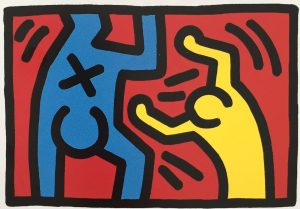





8am

8pm

10pm
|


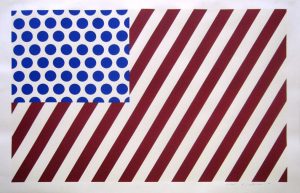
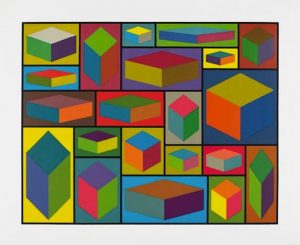
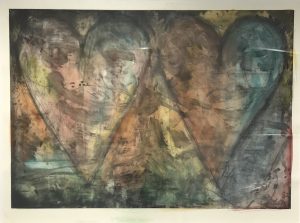
| Jim Dine Watercolored by Jim 2015 Watercolor and copperplate etching 42 x 56 1/2 in. Edition of 6 unique hand-painted pieces Pencil signed, dated, titled and numbered |
About the work:
During the early 1960s, with Pop Art in full swing, one of its earliest champions, Jim Dine, had already moved away from its ideas and was striking out on his own. Marked by a compulsive repetition of subject matter yet tempered with humanity and warmth, the oeuvre that the artist has produced over the last 60 years forms one of the most original bodies of work in 20th- and 21st-century art.
Among his iconic images, hearts are prominently featured. Dine has laid undisputed claim to the simple shape, suggesting boundless possibilities endowed with complex meaning. While repetition was a common motif in Pop Art, Dine employed it to a very different end. Pop was playing with art as mass culture while Dine was imposing a personal, lyrical individualism into his faceless forms. A self-described romantic artist, Dine has embraced the heart as a template through which he could explore relationships of color, texture, and composition. It is a subject of his work that is invested with rich personal significance.
This week’s Work of the Week! WOW! is Watercolored by Jim.
Dine painted his first heart in 1966, developed as a form of self-portraiture while he went through psychoanalytical treatment. The heart-themed works are defined by introspection and emotional vigor, continuously reinvented through the artist’s tactile brushwork, and inventive printmaking techniques. Dine uses the symbolism of the heart for its obvious connection to the strong emotions of love, but also for its values as a geometric framework within which dynamic color relationships and textures can be explored.
The powerful presence of the two hearts in Watercolored by Jim suggests human interaction, the smoky texture is combined with soft fields of watered-down color suggest a complex delicacy. Despite its lightness, it is strong work, as Dine’s expressionist energy is freed from the form. The colors vibrate against one another, fill and bleed beyond the hearts outlines in an organic blending into dense layers.
Dine has a distinct approach to printmaking, it provides him with an opportunity to focus his creative energy on small editions of works that are often experimental in technique and finished by hand. Watercolored by Jim is an edition of 6 unique hand-painted works with watercolor (hence the title) in which only the black lines are printed through copperplate etching.
The work is a tour de force of Dine’s experimentation with innovative monotype and other printmaking techniques. The traditional etching techniques combined with hand-applied details result in this distinctive work that bridges printmaking and painting.
With this painterly work, Dine continues to reinvent the form. The artist’s assertive brushwork is heightened by a soft texture endowing one of his most iconic images with fresh and exciting energy.
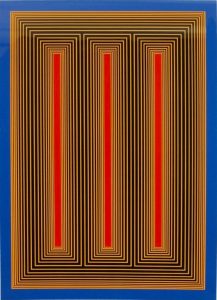
| Richard Anuszkiewicz Temple of the Golden Red 1985 Screenprint 32 x 24 in. Edition of 175 Pencil signed, dated and numbered |
About the work:
“I’m interested in making something romantic out of a very, very mechanistic geometry. Geometry and color represent to me an idealized, classical place that’s very clear and very pure.“ Richard Anuszkiewicz
Richard Anuszkiewicz was a central figure, along with Briget Riley and Victor Vasarely, in the Op Art movement. As a graduate student at Yale, he was mentored by the color theorist Josef Albers who would steer him on a course toward pure abstraction, grounded in the power of color. Most of his work trends away from personal emotion and drama, seeking rather visual investigations of formal structural and color effects. He made extensive use of ‘simultaneous contrast’ – where two colors, side by side, interact with one another to change our perception of them accordingly.
Among his most famed suites is the Temple Series; mesmerizing works, saturated with vibrant color arranged in geometric abstract compositions. The Temple Series originated after a 1981 trip to Egypt. He was inspired by the geometries of sacred temples,specifically those located in the Valley of the Kings. As is characteristic of most of his works, there are no specific references to individual structures, instead he uses the geometric framework as a space of color experimentation. The works in the series have been interpreted as illustrating visionary architect Buckminster Fuller’s notion of ‘Tensegrity’ – the balance between the forces of tension and integrity inherent in a physical structure.
This week’s Work of the Week! WOW! from the Temple Series is Temple of the Golden Red.
Temple of the Golden Red is a quintessential example of Anuszkiewicz’s mature style. Incorporating a repeating pattern of vertically oriented rectangles surrounded by concentric lines of startlingly different color. It contains three central rectangles of saturated crimson surrounded by lines of alternating but as equally saturated yellow and black. Symmetry is essential in Anuszkiewicz’s work, and by juxtaposing opposite colors of equal saturation, he accomplishes a visual fluctuation between figure and ground, creating a vibrating or pulsating sensation in the eye. The result is a release of energy, a transformation of color into motion. Like all great work that depends in large measure on color for its impact, the intensity lays in the way the eye and brain interpret visual information.
As with most artworks, Anuszkiewicz’s work is much more powerful in person. From Temple of the Golden Red emanates a profound luminosity, appearing as if lit from an inner source. New York Times art critic Holland Cotter described Anuszkiewicz’s works by stating, “The drama – and that feels like the right word – is in the subtle chemistry of complementary colors, which makes the geometry glow as if light were leaking out from behind it.” The artwork also packs a powerful monumentality, a result of its architectonic framing that gives the illusion of standing in front of a physical temple. Despite that the work is inspired from a trip to Egypt, the ‘fluting’ can seem to have more in common with classical ancient Greek columns.
Within the boundaries Anuszkiewicz set for himself—vertical bars of color surrounded by the pinstriped framework, the range of effects achieved is remarkable. The colors appear to blaze forth or recede into the distance and the choice of colors projects a mood, in this case, a jazzy up-tempo. Despite the restless optical power of the piece, it is thoroughly classical.
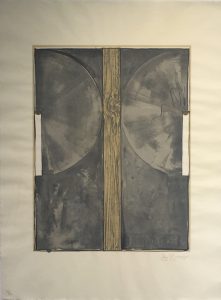
| Jasper Johns Device 1971-72 Lithograph 33 1/2 x 29 in. Edition of 62 Pencil signed, dated and numbered |
About the work:
“I tend to like things that already exist.” Jasper Johns
Jasper Johns is the world’s most critically acclaimed living artist. His work bridges the immediate post-World War II modernist trends of Surrealism and Abstract Expressionism with subsequent movements of Pop art, Minimalism, and Conceptual art.
Johns was ushered into the New York art scene in 1953, when he met Robert Rauschenberg. The two artists shared an intense relationship, both romantic and artistic, from 1954 to 1961. They had neighboring studio spaces and deeply influenced each other’s artwork, exchanging ideas and techniques that would allow them to break from Abstract Expressionism. Their relationship would lead to Johns’ discovery by famed art dealer Leo Castelli, who, while visiting Rauschenberg’s studio met Johns and saw his work. Castelli offered the young Jasper Johns his first solo show on the spot. It was during his first exhibition that Alfred Barr, the founding director of the MoMA, purchased a number pieces that were on display, instantly making Jasper Johns a force in the art world.
Johns’ breakthrough style was to appropriate popular iconography in his works with a rich treatment of the surface as lush and painterly. By representing common objects and images in the realm of fine art, Johns broke down the boundaries traditionally separating fine art and everyday life. However, rather than direct representation or abstraction, Johns made signs, like flags and targets, iconic images in his works. The “things the mind already knows” were his ideal subject because of the varied meanings each carried with it. This would lay the foundation for the Pop art movement’s aesthetic embrace of commodity culture, paving the path for Andy Warhol, James Rosenquist among many, many other post-war artists.
While Johns continued to produce paintings that incorporated Abstract Expressionism’s gestures and color blocking, he shifted his focus from the finished image to the concept behind it. His process, which he believed to be the actual art, took on greater importance. The artist made a seamless transition into print making. For Johns, printmaking was a medium that encouraged experimentation through the ease with which it allowed for repeat endeavors. His innovations in screen printing, lithography, and etching revolutionized the field.
As the Pop art movement grew around him, Johns left behind the colorful works filled with familiar gestures and images and turned to a darker palette. Some critics attribute the shift away from color and toward the grays, blacks, and whites that dominate many of his canvases from the early 1960s to the rocky end of his relationship with Rauschenberg.
This week’s Work of the Week! WOW! is Jasper Johns’ Device.
Created in 1971-72, Device masterfully plays with different tones of grey, white and beige. The works that use what Johns called “the device,” were made from two stretcher bars attached to a canvas frame with butterfly screws, creating a mechanical arm, that would be used to scrape the paint on the surface in a circular shape. All of these elements from the “real” world undercut the traditional idea of a painting as an illusion. The development of the device theme in Johns’ work progressed to incorporate other themes, such as the abundant use of text. His techniques stress conscious control rather than spontaneity.
Over the past fifty years Johns has created a body of rich and complex work. His rigorous attention to the themes of popular imagery and abstraction has set the standards for American art. Constantly challenging the technical possibilities of printmaking, Johns laid the groundwork for a wide range of experimental artists that came after him.